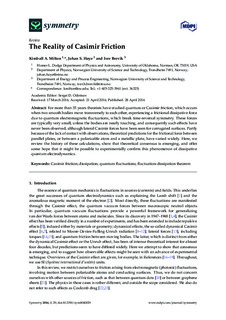| dc.contributor.author | Milton, Kimball A. | |
| dc.contributor.author | Høye, Johan Skule | |
| dc.contributor.author | Brevik, Iver Håkon | |
| dc.date.accessioned | 2018-01-03T09:13:49Z | |
| dc.date.available | 2018-01-03T09:13:49Z | |
| dc.date.created | 2016-04-30T16:05:52Z | |
| dc.date.issued | 2016 | |
| dc.identifier.citation | Symmetry. 2016, 8 (5), . | nb_NO |
| dc.identifier.issn | 2073-8994 | |
| dc.identifier.uri | http://hdl.handle.net/11250/2474244 | |
| dc.description.abstract | For more than 35 years theorists have studied quantum or Casimir friction, which occurs when two smooth bodies move transversely to each other, experiencing a frictional dissipative force due to quantum electromagnetic fluctuations, which break time-reversal symmetry. These forces are typically very small, unless the bodies are nearly touching, and consequently such effects have never been observed, although lateral Casimir forces have been seen for corrugated surfaces. Partly because of the lack of contact with observations, theoretical predictions for the frictional force between parallel plates, or between a polarizable atom and a metallic plate, have varied widely. Here, we review the history of these calculations, show that theoretical consensus is emerging, and offer some hope that it might be possible to experimentally confirm this phenomenon of dissipative quantum electrodynamics. | nb_NO |
| dc.language.iso | eng | nb_NO |
| dc.publisher | MDPI | nb_NO |
| dc.relation.uri | http://www.mdpi.com/2073-8994/8/5/29/pdf | |
| dc.rights | Navngivelse 4.0 Internasjonal | * |
| dc.rights.uri | http://creativecommons.org/licenses/by/4.0/deed.no | * |
| dc.title | The reality of Casimir friction | nb_NO |
| dc.type | Journal article | nb_NO |
| dc.type | Peer reviewed | nb_NO |
| dc.description.version | publishedVersion | nb_NO |
| dc.source.pagenumber | 12 | nb_NO |
| dc.source.volume | 8 | nb_NO |
| dc.source.journal | Symmetry | nb_NO |
| dc.source.issue | 5 | nb_NO |
| dc.identifier.doi | 10.3390/sym8050029 | |
| dc.identifier.cristin | 1353408 | |
| dc.relation.project | Norges forskningsråd: 250346 | nb_NO |
| dc.description.localcode | © 2016 by the authors; licensee MDPI, Basel, Switzerland. This article is an open access article distributed under the terms and conditions of the Creative Commons Attribution (CC-BY) license (http://creativecommons.org/licenses/by/4.0/) | nb_NO |
| cristin.unitcode | 194,66,20,0 | |
| cristin.unitcode | 194,64,25,0 | |
| cristin.unitname | Institutt for fysikk | |
| cristin.unitname | Institutt for energi- og prosessteknikk | |
| cristin.ispublished | true | |
| cristin.fulltext | original | |
| cristin.qualitycode | 1 | |

